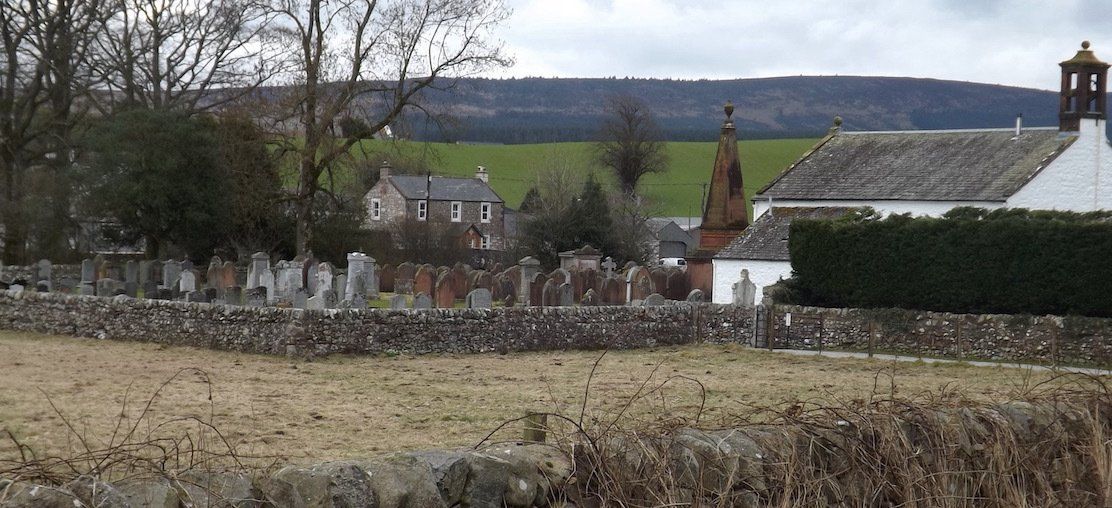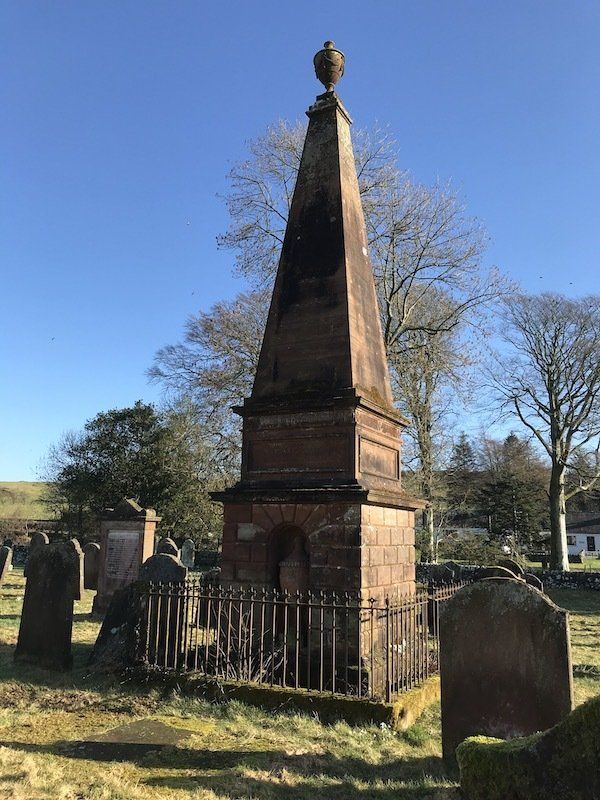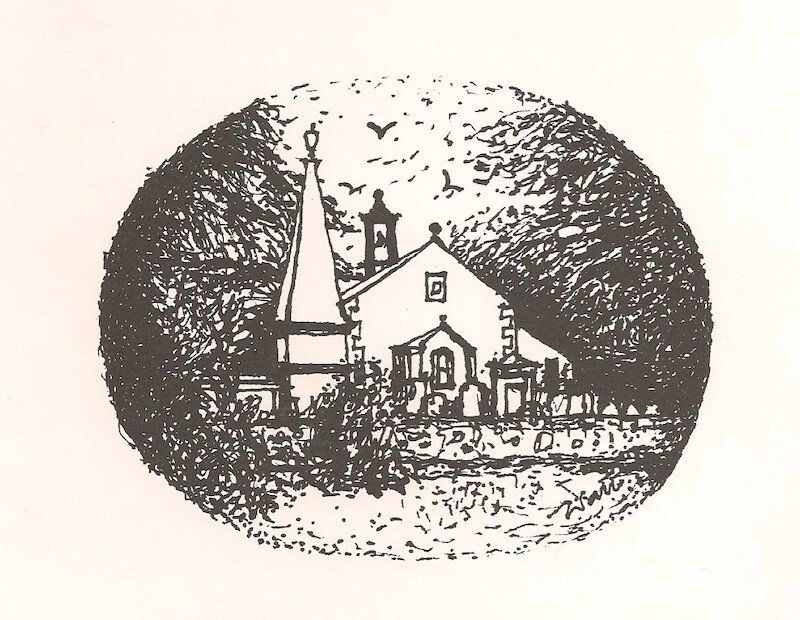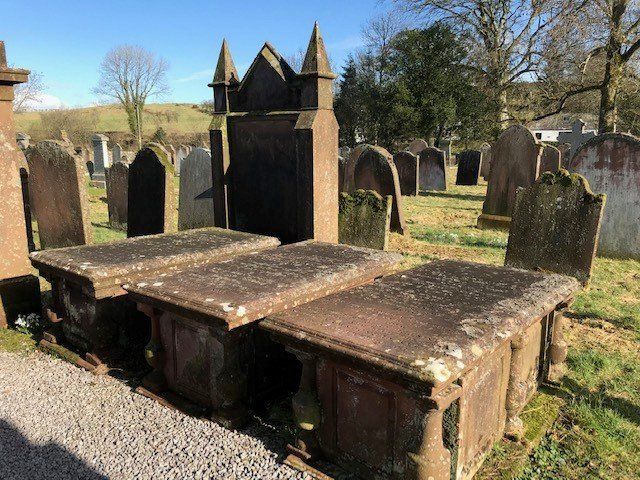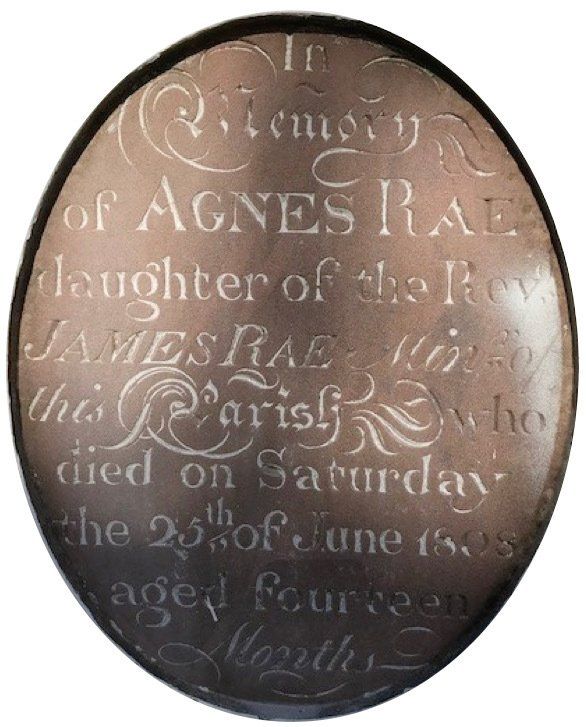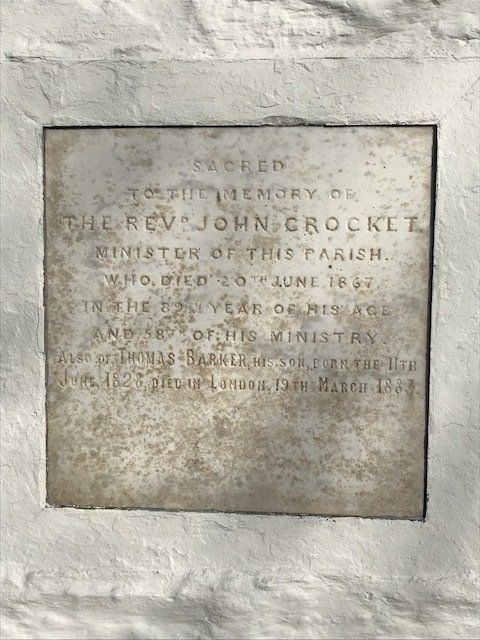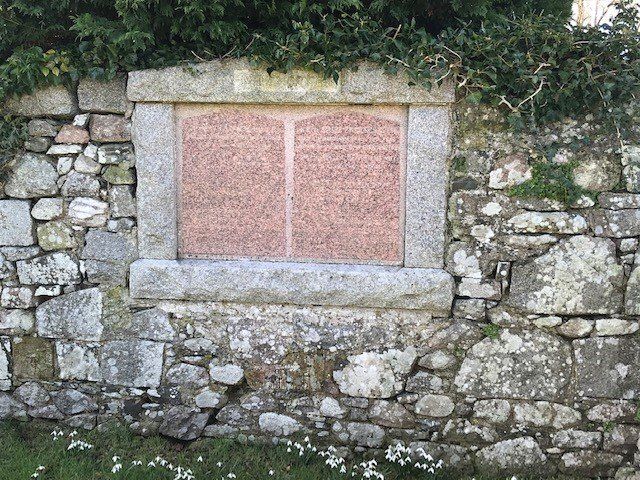MEMORIALS AND THE McWHIRE MONUMENT | GRAVES OF MINISTERS | THE BUCHANITES
Kirkgunzeon Churchyard
Along with the Church, the churchyard including the walls and tombstones are designated as listed buildings by Historic Buildings Scotland (listed building ref. LB9677) The original Churchyard, which surrounds the Church and extends to the east contains 18th and 19th century memorial stones. The burial ground was extended to the north around the end of the 19th century and it is still in use today. There are two lanes leading to the Churchyard, from the west and the south (the south lane is pedestrian access only - No vehicular access.) These are public rights of way and visitors are welcome although you are requested to respect the sacred nature of this place. Please keep dogs on a lead and clean up after them. On the west gatepost, where the south lane joins the road, is an inscription RR 1791, although it is not known who or what this refers to.
Memorials and The McWhire Monument
A listing of the older memorials, with inscription details and a numbered location plan, was compiled in 2021. This includes the two earliest sections of the churchyard, the south section which extends around behind the church and contains the earliest visible graves, or lairs, (eighteenth century from 1704 onwards) and the central section which forms part of the later extension. The graves in this section date from the nineteenth century onwards. Dumfries and Galloway Council hold records of the more recent burials which are in the north section. In addition to names and places some older memorials include details of occupations. As an agricultural parish farmer is the most common, others mention schoolteachers, stone masons, millers, shoemakers, surgeons and blacksmiths. The oldest visible memorial stones date from the first half of the 18th century, with the earliest being that of Thomas Heslop of Lochend who died in 1704.
One of the most striking monuments is the large sandstone obelisk to the McWhire family, which has separate listed status (LB9678). The listing describes it as, 'circa 1831, a monument in 3 stages; rusticated lower stage with urn in niche which supports a podium with dedicatory inscription. Above rises a tall sandstone obelisk with an urn finial.' The monument can also be seen on this drawing of the Church by Archie Sutter Watt, a teacher and artist who made his home in Kirkgunzeon from the 1950s until his death in 2005. He is buried in the churchyard with his wife Morag.
McLachlan Family Memorial
Another railed grave which stands towards the rear of the Church is that of the McLachlan family. On the large stone, beneath the parents’ names is recorded a son, James McLachlan, a surgeon in Dumfries who died in 1848. In December 1846 James McLachlan is thought to have assisted at one of the first surgical operations carried out in Europe with the use of a general anaesthetic. The enclosure also includes a smaller stone, the only memorial to include a trade emblem, that of blacksmith James McLachlan who died in 1793. The emblem is a crown and hand, holding a hammer
‘By hammer in hand trades do stand.’
Carsewell Family Memorial
An interesting memorial near the church is dedicated to the Carswell family. It mentions John Carswell, a Chief Mate who was killed in 1863 during a mutiny on the ship Flowery Land. This led to a famous trial and execution of five mutineers in 1864. In 1899 these events were written up by Sir Arthur Conan Doyle in ‘A True Story of the Tragedy of the Flowery Land’.
Graves of Ministers
Rev John Miller (minister 1702-1747)
On a flat stone, which is quite badly worn, in a small, railed section at the front of the church is the following inscription:
Here is interr’d the body of the late Reverend Mr John Miller, Minister of the Gospel in this parish, who was ordained the 24th September 1702. He continued at the faithful and Diligent of hi.. sacred office…(here the inscription grows faint) The date of death is 23rd February 1746.
Taken from ‘The Churchyards of the Stewartry of Kirkcudbright.’ James Matthewson 1913
Rev William Clarke (minister 1747-1786)
Matthewson also notes that the tombstone of the Rev William Clarke who succeeded Rev Miller and was minister between 1747 -1786, had disappeared.
Rev James Heron (minister 1786-1801)
Mathewson goes on to say that at the East end of the church are three large table graves, one containing the names of three sons and another those of three daughters of the Rev James Heron, whilst the third has the following record:
Sacred to the memory of the Rev James Heron. Admitted Minister of Kirkgunzeon 8th June 178. He died 31st July 1801, in the 46th year of his age. His religious sentiments were liberal and his piety sincere. He was a warm hearted relative and friend, a candid upright and benevolent man.
Rev Heron was minister from 1786 – 1801 and he was the author of the first
Statistical Account of the Parish (1791).
He is also mentioned in a letter from Robert Burns to his friend William Nicol written on 9th February 1790. This letter supports the view expressed in his epitaph that Rev Heron held liberal views, with Burns reporting the negative reactions this provoked in of some of the other local clergy. It was during the ministry of Rev Heron that the old church was demolished and the current one build (1796.)
Rev James Rae (minister 1802-1809)
Rev James Rae, who followed Rev Heron and was minister from 1802-1809 is not buried in Kirkgunzeon, although there is a small plaque to the East end of the front church wall dedicated to the memory of his daughter Agnes who died 25th June 1808 aged 14 months. It is one of many poignant inscriptions which give details of the deaths of children. Rev Rae was transferred to Parton and is there interred.
Rev John Crocket (minister 1809-1865)
Two other wall tablets are set into the front of the church. One is dedicated to Rev John Crocket (minister 1809-1865) and his son Thomas. The other to his wife Margaret Goldie and two other sons James and John. The tablet to Rev Crockett notes his death as 20th June 1867, in the 89th year of his age and 58th of his ministry. Rev. Crockett is the author of the second Statistical Account of the Parish (1844) and an account of his life can be found here.
Rev James Gillespie (minister 1865-1918)
Set into the wall, near the West entrance to the churchyard, is a plaque dedicated to Rev James Gillespie (minister 1865-1918) and his family. Rev Gillespie died on 9th March 1918 in his 78th year, the 53rd year of his ministry in Kirkgunzeon. Rev Gillespie is named as one of the original trustees of Maxwell Memorial Hall in the 1906 Deed of Trust. He also produced an article on Parish history, Notes on the Parish of Kirkgunzeon (1912) which was published in the Transactions and Journal of the Dumfriesshire and Galloway Natural History and Antiquarian Society.
Rev James Taylor Lornie (minister 1918–1923)
In the central section of the churchyard is the grave of Rev James Taylor Lornie (minister 1918–1923) and his wife Marjory.
He died 24th Jan 1923 in his 36th year.
James Morrison (Interim Moderator 1988-89)
Also buried in the modern section of the churchyard is James Morrison who was an interim moderator of the church in 1988-89. Mr Morrison died in 2008, and his wife Jean, who died in 2019, is also buried here.
The Buchanites
The churchyard also has a rather macabre link with the story of the late 18th-century followers of Elspeth Buchan, a Scottish woman who declared herself a prophet and claimed to be immortal and able to give immortality to her followers. As with other controversial religious sects at the time, the Buchanites were disapproved of by mainstream society and were forced to leave Ayrshire where they originated, eventually settling in what it is now Crocketford in 1787.
Despite her claims to immortality, Elspeth Buchan died in 1791 although at the time there were many rumours about what had happened to her body, as she had told her followers she would return to it. According to some accounts she was buried in a grave in Kirkgunzeon churchyard, only to be disinterred twice. The first time the coffin was reburied, and the second time, shortly afterwards, her body was removed and taken elsewhere. The sect formally came to an end when its last adherent, Andrew Innes, died in 1846.

